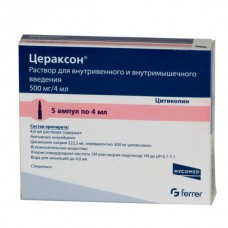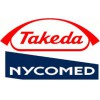Expiration date: 04/2026
The composition and form of issue:
Solution for intravenous and intramuscular injection. 4 ml containans active substance:
citicoline sodium 522, 5 mg
(equivalent to 500 mg of citicoline)
citicoline sodium 1045 mg
(equivalent to 1000 mg of citicoline)
excipients: 1M hydrochloric acid or 1M sodium hydroxide to pH 6, 7-7, 1 water for injection to 4 ml
in ampoules of neutral glass (hydrolytic type I) with protective plastic tube and a white strip for breaking ampoules of 4 ml, in a contour acheikova packing PVC 3 ampoules in a cardboard bundle 1 package contour acheikova package 5 ampoules, in a cardboard unit 1 or 2 packaging.
The oral solution 100 mg/ml. 100 ml contains:
active substance:
citicoline sodium 10, 45 g
(equivalent to 10 g of citicoline)
excipients: sorbitol glycerol methyl parahydroxybenzoate parahydroxybenzoate glycerol formal sodium citrate dihydrate, sodium saccharin crimson dye (Ponceau 4-R) strawberry flavoring (essence of strawberry 1487-S-Lucta) potassium sorbate citric acid 50% solution purified water to 100 ml
in bottles of colourless transparent glass, 30 ml, screw-capped plastic lid, complete with a dosing syringe in a carton pack 1 set.
Description pharmaceutical form:
Solution for intravenous and intramuscular injection. Clear, colorless liquid.
The solution for the reception inside. Transparent pink liquid with a characteristic strawberry odor. Allowed crystals to almost white in color.
Pharmacokinetics:
Suction. Citicoline is well absorbed in the on/in and/m introduction.
Metabolism. The on/in and/m introduction citicoline is metabolized in the liver with the formation of choline and cytidine. After the introduction of the concentration of choline in the blood plasma significantly increased.
Distribution. Citicoline is largely distributed in the brain structures with a rapid introduction of choline fractions structural phospholipids fraction and cytidine — cytidine nucleotides and nucleic acids. Citicoline penetrates into the brain and actively integrates into cellular, cytoplasmic and mitochondrial membrane, forming part of the fraction of structural phospholipids.
Excretion. Only 15% of the administered dose of citicoline is excreted from the human body is less than 3% in the kidneys, and about 12% in exhaled CO2.
Citicoline excretion in urine can distinguish 2 phases: the first phase, lasting about 36 hours, during which the rate of excretion rapidly decreases, and a second phase in which the rate of excretion decreases much more slowly. The same is observed in the exhaled CO2 elimination rate decreases rapidly after approximately 15 h, and then decreases much slower.
Description pharmacological action:
Citicoline, being the predecessor of key ultrastructural components of the cell membrane (mainly phospholipids), has a broad spectrum of activity — helps to restore damaged cell membranes, inhibits the action of phospholipase, prevents the excessive formation of free radicals and prevents cell death by acting on mechanisms of apoptosis. In acute stroke citicoline reduces the amount of damage to the brain tissue, improves cholinergic transmission. When TBI reduces the duration of post-traumatic coma and the severity of neurological symptoms, in addition, reduces the length of the recovery period.
In chronic cerebral hypoxia citicoline effective in the treatment of cognitive disorders such as memory impairment, lack of initiative, difficulty arising from carrying out everyday activities and self service. Increases the level of attention and consciousness, as well as reduces the appearance of amnesia.
Citicoline is effective in treating sensory and motor neurological disorders, degenerative and vascular etiology.
Indications:
- acute ischemic stroke (in the complex therapy)
- the recovery period of ischemic and hemorrhagic strokes
- TBI, acute (in the complex therapy), and recovery period
- cognitive and behavioral disorders in degenerative and vascular diseases of the brain.
Contraindications:
- hypersensitivity to any component of the drug
- patients with marked vagotonia (predominance of parasympathetic tone of the autonomic nervous system)
- children under 18 years (insufficient clinical data).
Application of pregnancy and breast-feeding:
Sufficient data on the use of citicoline in pregnant women. Although in animal studies adverse effects were not identified in pregnancy rug Ceraxon is prescribed only in cases when the expected benefit to the mother outweighs the potential risk to the fetus.
When assigning Ceraxon lactating women should stop breastfeeding because data on the allocation of citicoline with women's milk is not available.
Side effects:
The frequency of side effects
Very rare (<1/10000) (including individual cases):
Allergic reaction (rash, itching, anaphylactic shock), headache, dizziness, hot flashes, tremor, nausea, vomiting, diarrhea, hallucinations, edema, shortness of breath, insomnia, agitation, decreased appetite, numbness in the paralyzed limbs, changes in liver enzymes. In some cases, Ceraxon can stimulate the parasympathetic system and cause short-term changes blood pressure.
If any of the instructions side effects worsen, or have been seen any other side effects not mentioned in the instructions, you should inform the doctor.
Drug interactions:
Citicoline enhances the effects of levodopa.
Should not be administered concurrently with drugs, containing meclofenoxate.
Method of application and dose:
Solution for intravenous and intramuscular introduction
In/in, in/M. V/In, in the form of a slow intravenous injection (over 3-5 minutes, depending on the appointed dose) or drip/infusion (40-60 drops per minute).
In/in route of administration is preferable to V/M. in/m introduction should avoid repeated injection at the same place.
The recommended dosing regimen
The acute period of ischemic stroke and TBI: 1000 mg every 12 h from the first day after diagnosis, the duration of treatment for at least 6 weeks. 3-5 days after start of treatment (if not a violation of the swallowing function) the possible transition to oral forms of the drug Ceraxon.
The recovery period of ischemic and hemorrhagic strokes, the recovery period of brain injury, cognitive and behavioral disorders in degenerative and vascular diseases of the brain: 500-2000 mg per day. Dosage and duration of treatment depending on the severity of symptoms. Perhaps the use of oral forms of the drug Ceraxon.
Elderly patients
When assigning Ceraxon elderly patients dose adjustment is not required.
The solution in the vial is intended for single use. It needs to be used immediately after opening the ampoule.
The product is compatible with all types of I/isotonic solutions or solutions of dextrose.
The solution for the reception inside
Inside. Before use, the drug can be diluted in a small amount of water (120 ml or 1/2 Cup). Take during meals or between meals.
The recommended dosing regimen
The acute period of ischemic stroke and TBI: 1000 mg (10 ml) every 12 hours Duration of treatment for at least 6 weeks.
The recovery period of ischemic and hemorrhagic strokes, the recovery period of brain injury, cognitive and behavioral disorders in degenerative and vascular diseases of the brain: 500-2000 mg per day (5-10 ml 1-2 times a day). Dosage and duration of treatment depending on the severity of symptoms.
Elderly patients
When assigning Ceraxon elderly patients dose adjustment is not required.
Instructions for using the dosing syringe:
1. To put the dosing syringe into the vial (with the syringe plunger fully lowered).
2. Gently pulling on the plunger of the dosing syringe until the solution level is even with the appropriate mark on the syringe.
3. Before taking the correct amount of solution can be diluted in 1/2 Cup water (120 ml).
After each use, it is recommended to wash the dosing syringe with water.
Overdose:
Given the low toxicity of the drug cases of overdose not described.
Special instructions:
During treatment should use caution when performing potentially hazardous activities, require special attention and fast reactions (driving and other vehicles, work with moving machinery, work Manager and operator, etc.).
The solution for the reception inside (optional). Cold may form a small amount of crystals due to a temporary partial crystallization of the preservative. Upon further storage at recommended conditions, the crystals dissolve within a few months. The presence of crystals does not affect the quality of the drug.


